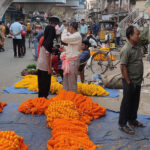It is easy to see how these bright flowers, in and among the tea gardens of the Uttar Dinajpur district of West Bengal, lend themselves to spring festivals and celebrations. The flowers are plucked by hand and then pressed and boiled in a 3-day process to turn them into organic abir – brightly coloured powder. This is also known as gulal or, of course, holi powder.
Trained by the Krishi Vigyan Kendra (KVK) initiative, the women first pluck the fresh blossoms from the fields. Processing the flowers into powder gives the women an alternative livelihood that helps supplement the family’s income.
In 2017 first 12 women from a local self-help group were trained, now some 250 women from ten villages in the Uttar Dinajpur district know how to make herbal abir.
The KVK initiative runs awareness campaigns in schools and government offices about the benefits of herbal holi colours to help create a demand.
What are herbal holi colours made of?
The women, like Srimati Biswas and Soma Mondal Das, choose the ingredients based on the required colour of the powder.
Typically the roots of turmeric make yellow powder, marigold flowers make orange holi powder and beetroot bulbs make pink powder.
The women crush the dried marigold flowers and then blend them in a mixer with water, which is then filtered to remove the dregs.
“We then boil the filtered liquid to make the colour deeper. Then we mix it with arrowroot powder and dry it in the shade at least for three days,” said Soma Mondal Das, while filling herbal powders in polythene bags.
Abundantly available marigold flowers in nearby farms makes it easy for women to supplement their income by making herbal abir, which is growing in popularity thanks to an increasing awareness among people about the harm of using chemical colours. The natural powder costs a little more than the chemical colours, but it is a price consumers are willing to pay.
Marigold in particular is cultivated extensively in small pockets of Bengal especially as there are many varieties, like orange, French, yellow, gold and cherry.
For many women making herbal holi colours is an additional income as they grow mushrooms for a livelihood otherwise. But during the Holi season and whenever there are elections, where abir is often used at political rallies, the women can earn a minimum of Rs 2,500 a month extra – which can make a huge difference to their households.
The convenience of working from home in their free time also attracted many women into the cottage industry.
Reporting and photographs by Gurvinder Singh, a journalist based in Kolkata.












